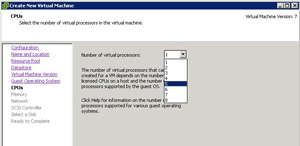Odd Processor Assignments
For most server consolidation implementations, running server operating systems with one or two virtual CPUs can address most situations. Rarely do I see a need for more processing power beyond two virtual CPUs, but there are always exceptions that can make an example.
With vSphere, we can now provision VMs with up to eight virtual CPUs. Further, we can introduce an odd number of processors available to the guest VM, as in Fig. 1, which shows a VM during the creation process and the option to assign three, five or seven processors.
 |
| Figure 1.VMs created with vSphere can now be provisioned with up to eight processors, including an odd-numbered inventory. (Click image to view larger
version.) |
VMware's docs recommend that VMs be provisioned with one virtual CPU. This is because the host can most efficiently manage the processing requests to honor one CPU cycle at a time, versus a request that must have two or more CPU cycles.
One quick note on compatibility: ESX 4 introduces Virtual Machine 7. Within ESX, machines from ESX 3.x work like version 4 and can still only be assigned one, two or four virtual CPUs.
In the case of odd-numbered CPU inventories, I remember back in the day when vendors used to offer three CPU servers. But, that was tacky then -- and it is probably tackier now. One of the only requirements-based reasons to assign three, five, or seven CPU VMs would be for licensing reasons. Beyond that, we could venture into configurations that may spell trouble down the road. I could just imagine a vendor saying "we don’t support odd-numbered CPUs -- except 1."
I am curious to your thoughts on the issue. Share your comment below or drop me an e-mail.
Posted by Rick Vanover on 06/01/2009 at 12:47 PM